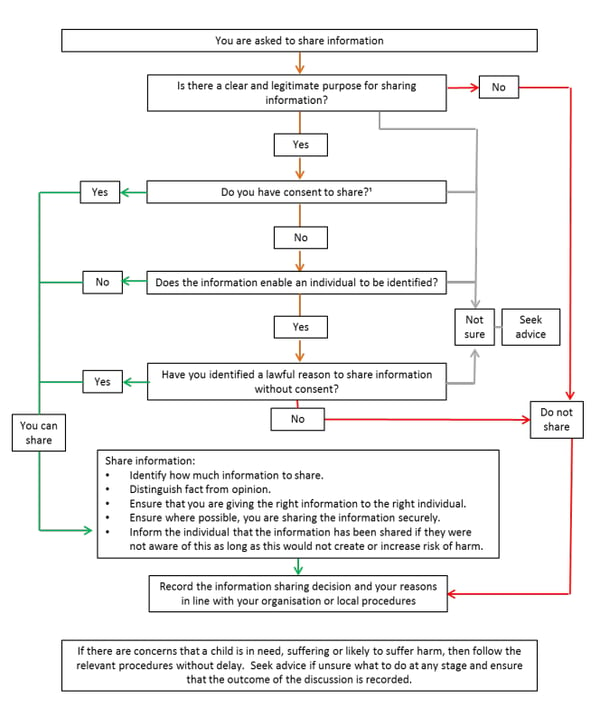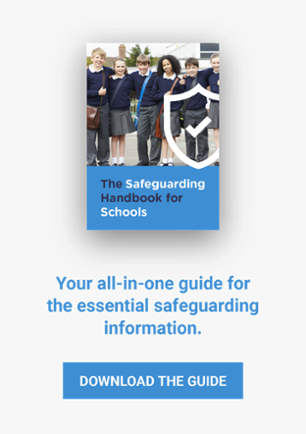How to Guide: Sharing Information for Safeguarding
It’s normal to feel overwhelmed and confused if a child reveals they’re being abused. It’s a challenging subject that can be both difficult to accept and talk about. However, you must be aware of your safeguarding information sharing (or disclosure) responsibilities so you can take the correct course of action to ensure the safety of the child or young person.
- Part One - How to Prepare for a Disclosure
- Part Two - What to Do During a Disclosure
- Part Three - The Next Steps: Reporting and Escalating a Disclosure
Part One - How to Prepare for a Disclosure
Although the abuse could be kept a secret out of fear, children experiencing distress may speak to you as they find you trustworthy and deem the school or college a safe place. It’s also not unusual for them to choose particular staff members that they feel have less authority or are less intimidating.
Regardless of your role, if a child approaches you to indicate abuse or disclose harm, your role is to recognise and refer the abuse - not to investigate. Although there’s no universal set of rules or a checklist on how to prepare for information sharing, there are several steps you can take to be best prepared.
Spotting the Signs
Your role as an educational practitioner means it’s vital you can spot the signs of the many types of abuse, both visible and hidden. Although it can be easier to see unexplained bruises, in cases such as grooming, a child or young person could be completely oblivious as to what’s really going on.
Before raising further suspicions, make sure you’ve spotted the correct signs. For example, if you notice a change in behaviour, don’t immediately assume the worst and take drastic action. It could be a family issue at home or even a falling out with a friend.
Instead, assess the situation. See if you can spot more signs of a type of abuse and then be prepared in case a child does approach you to share sensitive information. It’s also likely that a friend or third-party could inform you of the abuse instead. At the same time, you can’t force them to tell you what’s going on. Child abuse is a really difficult subject and takes a great amount of courage to speak up about.
This is why it’s vital you’re aware of the many different types of abuse a child or young person can suffer from and what the signs for each one are.
Picking a Suitable Location
Along with flagging the signs of abuse, neglect or harm, it’s equally as important to prepare a setting where a child will feel at their safest to share information. Choosing the middle of busy corridors to have this conversation, areas they’re not totally familiar with or poorly-lit areas aren’t the best locations to try and get a child to open up on their upsetting situation.
If a child has selected you as the staff member they feel comfortable talking to, then it means they feel safe around you, they can trust you and also feel as if the school or college is their safe place. So, it’s important to create an environment which reflects that.
Consider having this difficult conversation privately in an office without making it seem like the child is in any sort of trouble. It might also be better to sit with the child or young person in a classroom they’re familiar with and in a well-lit area so they’re at ease. By preparing the environment to be safe and comfortable, children and young people could be more inclined to disclose information without being fearful.
Stay Up-to-Date With Policies and Procedures
Arguably the most important way to prepare for a disclosure is to continue referring to your school or college’s policies, government procedures and attend regular training sessions. As safeguarding is such a sensitive topic, there are always new regulations you must stay aware of. Without this knowledge, you might not act in the correct or efficient way.
Always follow the safeguarding policies and procedures in your school or college when you have suspicions or a child has told you outright about the abuse they’re suffering. The guidelines will provide you with the most helpful tips on how to prepare for a disclosure, how you should act and the following steps you must take.
Until a child approaches a staff member to let them know of abuse they’ve suffered, you never know who a child or young person believes is a trustworthy or reliable figure. Even though you might believe they would never approach you, it’s still wise to stay on top of the policies, procedures and go on refresher courses if this does happen so you know the next steps.
Know Who to Approach for Advice
Along with knowing the policies and guidelines, ensure you know who you can lean on for some extra advice before the disclosure. For example, the Designated Safeguarding Lead (DSL) in your school or college must always be there for support and advice. However, it’s important to know this beforehand rather than wasting valuable time after a disclosure.
Always Have Resources Ready
It’s not a good idea to write down what a child says on a post-it note or loose piece of paper. This is really sensitive information which requires a lot of care and attention, so you need to have relevant resources ready in case a child or young person opens up about their abuse.
Even if you’re never involved in a disclosure and a child doesn’t share information with you, make sure you have resources ready such as files, folders, body maps and more. Not only does it show that you take this conversation seriously but it can also help authorities with their follow-up investigations.
By having resources on-hand, you can avoid making the child or young person wait for you to find relevant materials.
By doing all of the preparation, it puts you in the best position during a disclosure so you can handle it appropriately and with confidence.
Part Two - What to Do During a Disclosure
What should you do if a child comes to you and tells you they’re a victim of abuse? How do you react? Who do you speak to? Children have to grapple with a lot of issues, with a major one being the fear that nobody will believe what they say, so your actions during this information sharing are crucial.
You need to remain calm and show support to the child or young person throughout the disclosure process. By following these guidelines, you’ll help lessen the risk of potentially subjecting the child to more trauma or compromising a criminal investigation.
Listen
Listen carefully to what the child or young person is telling you. Avoid expressing your own views on the situation as a reaction of shock or disbelief. This could cause a child to stop talking. It’s natural to react to unpleasant news negatively or show anger but try to contain your emotions.
Displaying denial or shock at what they’re saying could cause a child to worry that you don’t believe them or you think badly of them. This can result in you not getting the full story or the child completely shutting down. Listen to everything they say without judgment and take everything seriously.
Also, be sure to stay calm throughout and at a steady pace to avoid rushing over important facts.
Reassure
Although offering reassurance is vital, you still need to be honest and reliable. Let the child or young person know they’re doing the right thing by speaking up. Offering them this reassurance can have a big impact, especially on someone who might have been suffering in silence and could now feel more at ease.
However, reassuring doesn’t mean offering promises you personally can’t keep, such as ‘everything will be all right now.’ Keep the focus on how they’ve done nothing wrong and that you’re taking everything they’ve said seriously. Don’t promise confidentiality either or agree to keep secrets. Although they’ve shown trust in you and might ask you to keep this information to yourself, it’s your duty to report your concerns.
Tell the child that you’ll need to inform some people, but only those whose job it is to protect children. Make it clear that not everyone will know so they don’t need to worry. Be sure to acknowledge how difficult it must have been to talk and how it takes a lot for a child to come forward so they’re always aware they weren’t in the wrong.
The child or young person also needs to know what will happen next with their information.
React
It’s normal to react angrily to the situation and be overwhelmed, but the child or young person is relying on you to comfort them with your presence and believe that you’re a shoulder they can lean on.
When reacting to the information they share, there’s a lot to keep in mind.
- Never Assume: Always listen quietly, patiently and carefully without skimming over details. The child or young person needs to drive this conversation so don’t assume anything, don’t speculate and don’t jump to any conclusions.
- Avoid Blaming: Make sure to tell the child repeatedly during the disclosure conversation that it’s not their fault. Abuse, neglect and harm is never a child’s fault so it’s vital you let them know.
- Don’t Confront Perpetrators: Although you might feel anger and frustration on the inside, don’t let this show and don’t feel the need to talk to the alleged abuser. Try to remain as calm as possible as a confrontation could make the situation worse for the child.
- Don’t Investigate: Don’t investigate, interrogate or decide if a child is telling the truth. An allegation of child abuse can lead to a criminal investigation so don’t do anything that could jeopardise a police investigation. Let the child or young person explain to you in their own words but don’t ask leading questions.
- Avoid Open Questions: Don’t ask open questions like ‘Is there anything else you want to tell me?’ You’re there to listen and take notes - not drive the conversation or force the child to tell you information as this could have a negative impact.
- Communicate Appropriately: You need to communicate in a way that’s appropriate to the child’s age, understanding and preference. For example, the way you talk to a child in Key Stage 1 would be different from a high school student.
- Avoid Repetition: It’s likely to have taken great courage to speak out once. To avoid putting any more strain or stress on a child, don’t put them in an uncomfortable position by asking them to repeat their story over and over again. Also, don’t ask the child to repeat what they have told you to another member of staff. Explain that it’s your job to involve the relevant people and who you’ll have to talk to next.
- Take Them Seriously: Emphasise that everything the child is saying is taken seriously. Make sure they know they’re not in trouble, they’re safe with you, you’re glad they spoke up about this and that you’re sorry this has happened to them. Also, make sure to tell them you’ll do everything in your power to make sure it doesn’t happen again and you know others who can be trusted to help them.
Record
As the child is talking and disclosing information, it can be difficult to keep up with everything. To avoid missing anything vital, make some brief notes as you go along at the time and then write them up in more detail as soon as possible. Make sure you accurately record everything a child tells you and what you observed without making any assumptions.
You’ll need all the details such as the date, time, place of the disclosure, their behaviour, the terminology they use (such as slang) and how the child or young person appeared to you. You need to be as specific as possible so your interpretation of the child’s account doesn’t lead to inadmissible evidence.
If you notice visible bruises or injuries, use a body map to record these important details. Ensure the map is dated and attached to the information relating to the child’s comments about their injuries. This information will be a big part of a case, especially since injuries can disappear over time - but you will have noted them down accurately.
Also, don’t destroy the notes that you make - even those rough notes you initially begin with. It’s likely that the court might need to look over everything you record. The disclosure might not be verbal either. Some children may also seek to disclose and share their experiences through drawings, writing and play.
If you’re concerned about what you’re observing, it will be appropriate to talk further with the child to allow for wider discussion and more clarity. For example, if you notice a picture you’re concerned about, you can ask the child to tell you more. If you’ve heard a story, tell them you found it interesting and want to know more about the characters, event, places, people and more.
Children might not always be aware they’re being abused. To them, it could be completely normal behaviour and don’t feel the need to bring it up. But if you do notice certain signs then you should take the appropriate steps from this section.
The Golden Rules to Sharing Information
The Information sharing - advice for practitioners providing safeguarding services to children, young people, parents and carers guidance sets out the process and principles for sharing information. Here are the seven golden rules to sharing information from the guidelines to support you when you need it.
- Remember that the General Data Protection Regulation, the Data Protection Act 2018 and human right law don’t limit justified information sharing for the purposes of keeping children and young people safe. They provide a framework to ensure personal information is shared appropriately.
- Be open with the individual and seek their agreement - unless it’s unsafe or inappropriate to do so.
- If in doubt, seek advice from other practitioners.
- Where possible, share information with consent and respect the wishes of those who don’t consent to have their information shared.
- Consider safety and wellbeing.
- Information sharing must be necessary, proportionate, relevant, adequate, accurate, timely and secure.
- Record decisions and reasons.
Following the guidelines above will help you if you’re ever a part of a disclosure. The next step is equally as important as you’ll record all of this sensitive information and then escalate it to the relevant people.
Part Three - The Next Steps: Reporting and Escalating a Disclosure
Before you can report and escalate a disclosure, it’s important to know the main principles and what information you should share. The Information sharing - advice for practitioners document also highlights these principles with the intention of helping you share information between relevant people.
When making decisions about what information to share, you should just use your judgement. But if you’re in doubt, follow your school or college’s procedures or consult with the DSL if needed. However, the most important consideration is whether sharing information is likely to support the safeguarding and protection of a child. So, keep these principles in mind:
The Principles
- Necessary and Proportionate: When making decisions about what information to share, consider how much information you need to release. Anything you share from the disclosure must be proportionate to the need and level of risk.
- Relevant: Only share relevant information to those who need it. This will allow others to do their job effectively and make informed decisions.
- Adequate: The information you share needs to be of the right quality so it can be understood and relied on.
- Accurate: Information must be accurate, up to date and should clearly explain what’s fact and what’s an opinion. If the information you have is historical, make sure to explain it.
- Timely: To reduce the risk of missed opportunities and offer support and protection to a child, information should be shared in a timely manner. Timeliness is key in emergency situations and it might not be appropriate to seek consent for information sharing if it can cause delays and put a child or young person at an increased risk of harm. Ensure that enough information is shared as well as the urgency with which to share it.
- Secure: Make sure your school or college’s policy on security is followed for handling personal data. Wherever possible, the information should be shared appropriately and securely.
- Record: You should record information sharing decisions, whether or not the decision is taken to share. If the decision is to share, reasons should be cites, such as what information has been shared and with who in line with your school or college’s procedures. Any information you do have should also not be kept longer than necessary.
When You Should Share Information
When you’re asked to share information, you need to consider the following questions to help you decide if and when to share.
- Is there a clear and legitimate purpose for sharing information?
- Do you have consent to share?
- Does the information enable an individual to be identified?
- Have you identified a lawful reason to share information without consent?
How You Should Share Information
In relation to how you should share information, consider these issues as well:
- Identify how much information you will share.
- Separate fact from opinion.
- Ensure you give the right information to the right individual.
- Ensure that you share the information securely.
- Be transparent and inform them that the information has been shared - as long as doing so doesn’t create or increase the risk of harm to the child or young person.
For a better understanding of when and how to share information, take a look at the flowchart below.
It’s also vital you report the abuse as soon as possible after the disclosure, inform the DSL and tell the police if necessary. This can depend on the case and type of abuse a child or young person has suffered from.
That’s not the end at this stage. A child has shown great courage to speak to you about this upsetting situation and they’ve chosen you as somebody they trust. Even after you share this information, maintain contact with the child to show you support them so they don’t feel rejected. It’s important they feel you’re there for continued support.
Finally, make sure you have enough support for yourself. Dealing with a disclosure and sharing information about these types of difficult conversations can be frightening, traumatic and difficult to forget - especially if it’s the first case you’re involved in.
Escalating After a Disclosure
Thankfully, there are many steps available to report any safeguarding concerns you have. If you believe a child or young person is in immediate danger, don’t delay the entire process by going through disclosures. Although you must keep relevant people in the loop, such as the DSL, call the police on 999 straight away.
Here are some other ways to escalate your concerns:
- NSPCC: Contact the NSPCC on 0808 800 5000. They’ll pass the concern onto the local child protection team in your area to investigate further.
- Local Council: You can also report your safeguarding concern to your local authority child protection team. To find your local team and their contact details, click here.
- DSL: You also have the option to report a case directly to your DSL. If you’re the DSL for your school or college, then follow one of the first two steps.
- NSPCC Whistleblowing: The NSPCC also has a whistleblowing advice line on 0800 028 0285 or email them at help@nspcc.org.uk. They offer free support and advice if you’re concerned about how child protection issues are handled in your school, college or organisation.
- If you have concerns, you should follow your school or college’s child protection policy and speak to the DSL. This gives you further options, such as managing support for the child internally through your pastoral support process.
The government website has also highlighted the steps you must take if you have safeguarding concerns about a child. You can view the chart by clicking here.
Information sharing is one small yet vital piece of the safeguarding puzzle. It’s important you’re fully prepared on all things safeguarding, but it can be a lot to take in with a lot of information floating around. To get all of the essential information in one place, download our comprehensive handbook.
The Safeguarding Handbook
This robust handbook is your go-to resource for you and anyone else that works with children. Although you now have the knowledge on what to do before, during and after a disclosure, you still need to know more about the legalities, responsibilities, types of abuse, the signs to look out for and much more.
To get your copy, click on the link below.




